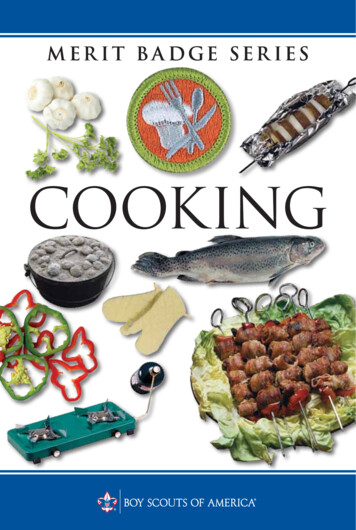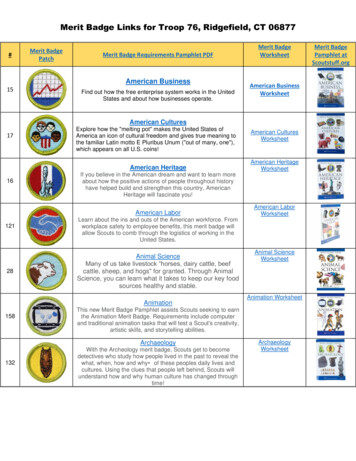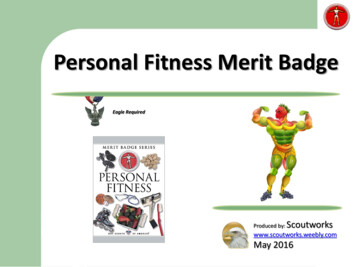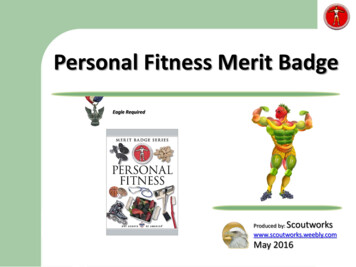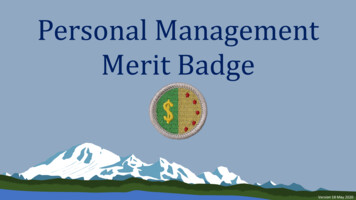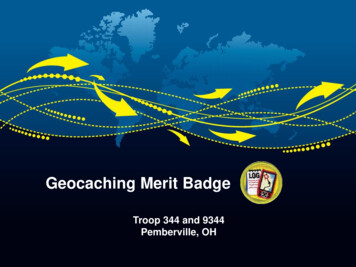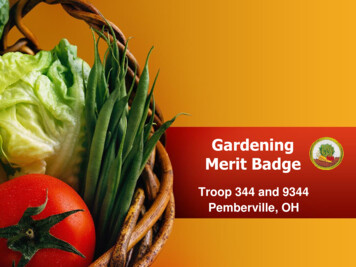
Transcription
GardeningMerit BadgeTroop 344 and 9344Pemberville, OH
Gardening Merit Badge Requirements1. Do the following:a. Explain to your counselor the most likely hazards associated withgardening and what you should do to anticipate, help prevent, mitigate,and respond to these hazards.b. Discuss the prevention of and treatment for health concerns that couldoccur while gardening, including cuts, scratches, puncture wounds, insectbites, anaphylactic shock, heat reactions, and reactions from exposure topesticides and fertilizers.2. Do the following, and discuss your observations throughoutthe process with your counselor:a. Grow six vegetables, three from seeds and three from seedlings, throughharvesting.b. Grow six flowers, three from seeds and three from seedlings, throughflowering.3. Give the nutritional value of the following:a. Three root or tuber crops.b. Three vegetables that bear above the ground.c. Three fruits.
Gardening Merit Badge Requirements4. Test 100 garden seeds for germination. Determine thepercentage of seeds that germinate. Explain why you thinksome did not germinate.5. Visit your county extension agent’s office, local universityagricultural college, nursery, or a botanical garden orarboretum. Report on what you learned.6. Explain to your counselor how and why honeybees are usedin pollinating food crops and the problems that face the beepopulation today. Discuss what the impact to humanitywould be if there were no pollinators.7. Identify five garden pests (insects, diseased plants).Recommend two solutions for each pest. At least one of thetwo solutions must be an organic method.
Gardening Merit Badge Requirements8. Do ONE of the following and record weekly observations.Discuss the results of your project with your counselor:a. Build a compost bin and maintain it for 90 days.b. Build a vermipost bin (worm compost bin) and maintain it for 90 days.c. Build a hydroponic garden containing three vegetables or herbs, or threeornamental plants. Maintain this garden through harvest or flowering, orfor 90 days.d. Build one water garden, either in a container (at least 12 by 6 inches and6 inches deep), or in the ground as a small, decorative pond no largerthan 6 by 3 feet and 24 inches deep. Maintain the water garden for 90days.e. Prepare a honey super for use on a hive or colony. Remove a filledhoney super from the hive or colony and prepare the honey for sale.
Requirement 1Do the following:a. Explain to your counselor the most likely hazards associated with gardening and what youshould do to anticipate, help prevent, mitigate, and respond to these hazards.b. Discuss the prevention of and treatment for health concerns that could occur while gardening,including cuts, scratches, puncture wounds, insect bites, anaphylactic shock, heat reactions, andreactions from exposure to pesticides and fertilizers.
Hazards of GardeningSunburn and Heat Exhaustion Extended sun exposure is bad for your skin. Protectareas like the back of your neck or your face. Theheat can also cause dehydration and heatexhaustion if you are not careful. Slather sunscreen (preferably SPF 30 ) on beforegoing out. You will sweat out the lotion whileworking so remember to re-apply every two hours. Put on a hat, a long sleeved shirt and shades if youplan to garden for an extended period. Stay in the shade when you can – Use an umbrellaon days when the sun is really intense and shortenyour gardening time. Stay hydrated by drinking lots of water or other coldbeverages but stay away from alcohol and caffeine.These drinks are diuretic and can causedehydration.
Hazards of GardeningInsect bites Tilling the soil and working with plantscan expose you to nasty bugs. Avoid ticks, which can be carriers ofdisease (among them Lyme disease). Prevent bites by using insect repellentand covering your skin. Tuck your pants into your socks andwear a hat. Check yourself before going inside thehouse to make sure that you’re notcarrying bugs and insects inside yourhome
Hazards of GardeningPoisonous chemicals Be careful about using pesticidesand fertilizers. Ask advice from an expert at yourlocal gardening center before usingthem or use organic mulches andfertilizers to be safe. If you decide to use chemicals foryour garden, follow instructions andwarning labels. Remember to keep pets andchildren away.
Hazards of GardeningAllergies Itchy eyes and occasional skin rashes are common, but if allergies get moreserious, see a doctor. Allergies change over a lifetime, and they can reactto seasonal growth patterns. So just because you weren't allergic tosomething last month doesn't mean you won't be this month. Antihistamines such as Benadryl can reduce the effects of allergies.
Hazards of GardeningCuts and scrapes Cuts and scrapes can be caused by sharpgardening tools, thorny plants, rocks and soildebris. Always wear thick gloves to protectyour hands, arms and shins. Considerupdating your tetanus vaccine (recommendedevery 10 years) before you do intensivegardening work. You can also damage your hearing throughnoisy machinery such as rototillers. Using hearing protection, safety glasses, andprotective clothing when using machinery, andgood maintenance of tools and machines willreduce risk. It also helps to ensure there areno loose stones in areas where you are usingmowers, weed-eaters and trimmers.
Hazards of GardeningBack problems Hours bent over tilling the soil or carrying heavy bags ofmulch and other gardening materials can strain your backor cause damage to your spine. To prevent back problems,remember to:––––Use a portable garden or kneeling stool – This can protect your spine,knees and joints when you’re working close to the ground.Get a wheelbarrow – This will make moving heavy things around thegarden easier. Ask for help if you need to load heavy things on yourwheelbarrow, otherwise, divide the load into smaller, more manageablechunks. Load heavy things the right way. For example, bend yourknees before lifting anything heavy.Take breaks – It’s very easy to overexert yourself when you’re enjoyinggardening. This can lead to intense muscle and back pain later on.Doctors recommend getting up and stretching every 30-40 minutes.Drink some water, stay in the shade and let your muscles recover.Wear proper shoes – Wear shoes that have traction, are secure onyour feet and have cushion and arch support. If the ground is slippery,wearing sandals or going barefoot can lead to a bad fall that can injureyour back.
Requirement 1Do the following:a. Explain to your counselor the most likely hazards associated with gardening and what youshould do to anticipate, help prevent, mitigate, and respond to these hazards.b. Discuss the prevention of and treatment for health concerns that could occur while gardening,including cuts, scratches, puncture wounds, insect bites, anaphylactic shock, heat reactions, andreactions from exposure to pesticides and fertilizers.
Simple Cuts and Scratches Simple cuts are skin injuriescaused by sharp objects.– Usually not very deep Scratches are areas ofdamage to the upper layersof skin.
Treatment for Cuts andScratches Wash the wound with soap andwater for 5 minutes.– Remove any bits of dirt, small pieces ofrock, or other debris. Apply an antibiotic ointment such asNeosporin and cover it with a BandAid or gauze.
Common Mistakes in TreatingCuts and Scratches Don't use alcohol or Merthiolate onopen wounds. They sting and damagenormal tissue. Don't kiss an open wound becausethe wound will become contaminatedby the many germs in a person'smouth. No kissing the Boo Boo! Let the scab fall off by itself; picking itoff may cause a scar.
Puncture Wounds Puncture wound first aid:– Wash your hands. This helps preventinfection.– Stop the bleeding by applying gentlepressure with a clean bandage or cloth.– Clean the wound thoroughly.– Apply an antibiotic (Neosporin). For thefirst two days, rewash the area andreapply the antibiotic when you change thedressing.– Cover the wound with a bandage.– Change the dressing daily or wheneverthe bandage becomes wet or dirty.– Watch for signs of infection and see adoctor if the wound isn't healing or younotice any spreading redness, increasingpain, pus, swelling or fever.
Insect Bites Bites of mosquitoes, chiggers (harvest mites), fleas, and bedbugsusually cause itchy, red bumps. The size of the swelling can varyfrom a dot to a half inch.Signs that a bite is from a mosquito are: itchiness, a central raised dotin the swelling, a bite on skin not covered by clothing, andsummertime,Fleas and bedbugs tend to bite skin under clothing. Flea bites oftenturn into little blisters in young children.Bites from horseflies, deerflies, gnats, fire ants, harvester ants, blisterbeetles, and centipedes usually cause a painful, red bump. Fire antbites change to blisters or pimples within a few hours.
Treatment of Insect Bites Apply calamine lotion or a bakingsoda paste to the area of the bite.If the itch is severe (as withchiggers), apply nonprescription 1%hydrocortisone cream four times aday.Do not to pick at the bites or theycan become infected or leave scars.Cold, moist compresses or ice onthe area can help.
Tick Bites Can transmit Rocky Mountain spottedfever or Lyme diseaseTick embeds it’s mouth parts in skin andmay remain for days sucking blood.
Engorged Tick
Tick Removal Grasp the tick’s mouthpartsagainst the skin, using pointedtweezers. Pull steadily without twistinguntil you can ease the tickhead straight out of the skin. DO NOT squeeze or crush thebody of the tick. DO NOT apply substancessuch as petroleum jelly, nailpolish, or a lighted match tothe tick while it is attached.
Tick Removal Cont. Once you have removed the tick,wash the wound site and yourhands with soap and water, andapply rubbing alcohol or antisepticto the site.Observe the bite over the next twoweeks for any signs of anexpanding red rash or flu-likesymptoms (Lyme Disease).Lyme Disease Rash
Bee Stings Honey bees, bumble bees,hornets, wasps, and yellowjackets can all sting.These stings cause immediatepainful red bumps.While the pain is usually betterin 2 hours, the swelling mayincrease for up to 24 hours.
Treatment of stings If you see a little black dot in thebite, the stinger is still present (thisonly occurs with honey bee stings).Remove it by scraping it off with acredit card or something similar.For persistent pain, massage with anice cube for 10 minutes.Give acetaminophen immediately forrelief of pain and burning.For itching, apply hydrocortisonecream.
Symptoms of AllergicReactions Difficulty breathing, wheezing.Tightness in throat or chest.Swelling of the face and neck, puffyeyes.
First Aid for Anaphylaxis(Severe Allergic Reactions) Call 911.Lay person flat – do not allow them tostand or walk. If unconscious, place inrecovery position. If breathing is difficult allowthem to sit up.Give adrenaline autoinjector (EpiPen).Monitor the victim’s breathing and beprepared to give CPR.
First Aid for Anaphylaxis(Severe Allergic Reactions) Emergency Epinephrine Kit (EpiPen)May be carried by people with severeallergies.Help the victim open and use the kit asneeded.
Dehydration When the body puts outmore liquid than it is takingin.Ways we lose fluids: Sweating.Urination.Vomiting.Signs of dehydration: Thirst.Yellow or dark urine.Dry mouth.Lightheadedness.Nausea and vomiting.Dry skin.Cease sweating. Treatment: Drink fluids (water,Gatorade).Avoid physical activity.Get inside air conditionedor cool area.
Heat Emergencies
Heat Exhaustion Symptoms Heavy sweatingThirstFatigueHeat crampsHeadacheDizzinessNauseaVomiting
First Aid for Heat Exhaustion Move victim from heat to rest in acool place.Loosen or remove unnecessaryclothing.Give water or a sports drink.Raise feet 8-12 inches.Put cool, wet cloths on foreheadand body – spray skin with water.Seek medical care if victim’scondition worsens or does notimprove within 30 minutes.
Heatstroke
First Aid for Heat Stroke Call 911.Move victim to cool place.Remove outer clothing.Cool victim quickly.Apply cold compresses or sprayskin with water. Put ice bags or cold packsbeside neck, armpits, and groin.
First Aid for Pesticide Exposure If someone has swallowed or inhaled a pesticide or gotten it in theeyes or on the skin:Call 911 if the person is unconscious, having trouble breathing orhaving convulsions.Check the label for directions on first aid for that product.Call the Poison Control Center at (800) 222-1222 for help with firstaid information.
First Aid for Pesticide Exposure
Requirement 2Do the following, and discuss your observations throughout the process with yourcounselor:a. Grow six vegetables, three from seeds and three from seedlings, through harvesting.b. Grow six flowers, three from seeds and three from seedlings, through flowering.
Gardening To be a good gardener, you will need to understand the science ofgrowing plants– How to prepare the soil.– How to select and plant seeds.– How to care for growing plants. Most vegetables and fruits grow best in full sunlight.You will need to decide whether to grow your garden in the groundor in containers.Before you plan your garden, find out about the agricultural regionwhere you live.– Knowing the region in which your garden is located will help you select the righttypes of plants to grow.
Growing Regions of the U.S.
Average Last Frost Date Map Average frost dates are one ofthe most important dates everygardener should know.Different plants vary in hardinessand ability to withstand frost andcold temperatures.It's best not to sow seeds orplant seedlings of tender, heatloving plants, such as Tomatoes,Cosmos or Basil, before theaverage date of the last springfrost unless you are ready toprovide protection.Some plants like cool-season annuals and vegetables, such as Pansy, Stock,Snapdragon, Broccoli or Peas, can withstand frost and can be planted asmuch as 6 weeks before the average date of the last frost in spring, often assoon as the soil can be worked.
Soils The earth in which plants grow is calledsoil.The upper layers of soil are usuallymade up of decaying plant materialsuch as leaves, mulch, and grassclippings.The lower layers of soil are made up ofrocks and minerals that have crumbledwith age and wear.Rain, earthworms, fungi, and bacteria help the upper layers break down.When the upper and lower layers combine, soil is formed.Sometimes a gardener may need to help the layers mix and this is called tillingor turning the soil.Some kinds of soil contain materials that are better for garden plots, and somekinds of plants grow only in certain kinds of soil.
Types of Soils Sandy Loam Soil:–– It contains a good mixture of sand and decayingmaterial and is good for most plants to grow.If there is too much sand, you will need to addorganic humus or compost to keep it from dryingout too quickly.Clay Loam Soil:––Is a heavy soil and makes gardening difficult. Itdries out slowly and sometimes forms a crust ontop.Clay is not good for gardening unless you addsand and organic matter, such as compost, tomake it easier for plant roots to grow and waterto drain.
Types of Soils Mucky Soil:––– Is dark, rich in nutrients, and very good forgrowing many different kinds of vegetables.The nutrients from decaying organic materialprovide a lot of food for plants.If the mucky soil in your garden does not drainwell, add sand and then till the plot beforeplanting.Peat Soil:––––Contains decaying vegetable matter, usually froma forest floor, that is high in carbon.Carbon is a nutrient that helps plants grow.Peat soil is light and almost dusty.If your garden area contains only peat, addtopsoil, organic humus, or compost, and then tillthe plot before planting.
Planning Your GardenBefore you plant your garden, decide what crops you want to grow. Step 1: What Vegetables Do YouLike?Step 2: What Vegetables Do YouEat Regularly?Step 3: Review Those Lists– Read through both of your lists andhighlight the vegetables whichappear on both lists. It is thosevegetables you should focus ontrying to grow first.
Planning Your Garden Step 4: Decide where to grow the garden.Step 5: Get a piece of paper and a pencil and map out where you will planteach crop.– If you are a new gardener, try to limit the number of plants and varieties you areplanting in order to keep your garden manageable while you are learning.– Limit the number of plants based on the space you intend to plant in.
Planning Your Garden Step 6: Decide how you will start yourcrops.– You can buy seeds or young plants. Step 7: Visit the plot of land where yourgarden will be located and decide what youneed to do to prepare the ground.
Growing from Seeds Planting seeds into the soil outdoors is called direct sowing, and it's an easyprocess that yields great results.Unlike indoor seed starting, direct sowing involves unpredictable elements:weather, wildlife and insects.Even so, many vegetables, annuals, herbs and perennials sprout easily fromseed sown directly into garden soil.
Growing from SeedsStep by Step Instructions for Direct Sowing1. Prepare Soil – Use a rake or hand fork to loosen soil. Break apart large soilclumps, and remove debris, such as sticks, rocks and roots. Add amendmentsto soil, such as fertilizer and organic matter, to create the most ideal growingsituation. Finish by creating a level surface.2. Dig In – Most seed packets describe planting depth. The rule of thumb is toplant at a depth equal to three times the seed diameter.– If your soil has a high clay content and tends to crust over as it dries, cover seedswith commercial seed-starting mix.– When sowing extremely small seeds, such as carrots, mix seeds with sand to aid indispersal.– When sowing larger seeds, including peas and beans, create a long furrow anddribble seeds at the proper spacing. Alternatively, use a bamboo stake, dibber orpencil to form individual planting holes.
Growing from Seeds3. Moisture Matters – After planting, water seeds with a gentle mist or shower.Avoid using a strong splash or spray, which can dislodge seeds. It's vital tokeep soil consistently moist. In a sunny spot, this may mean watering twice aday.4. Stake The Spot – Mark planting areas, especially if they're tucked betweenexisting plantings. Use garden markers, stakes and string, tall sticks, plasticcutlery — anything that clearly defines where seeds are buried.5. Identify Seedlings – Learn what your seedlings will look like so you don'tmistakenly pull them as weeds. Some seed packets show seedlingappearance; you can also find illustrations or photos online. When in doubt, letthe seedling remain until you know for sure if it's friend or foe.6. Thin Seedlings – Thin seedlings as directed on the seed packet. You'll disturbroots less if, instead of pulling seedlings you're removing, you snip seedlings atthe soil line with a fingernail or a tiny pair or snips or scissors.7. Watch For Pests – Keep an eye out for and protect seedlings against Slugs,Snails, Cutworms and other insect pests.
Growing from Seedlings Your garden has a better chance of surviving outdoorsif you plant seedlings that already have roots.You can purchase seedlings or start your garden byplanting seeds indoors in seed trays or small pots.– Fill containers with soil to within ½ inch of the top.– Place one or two seeds in each container and lightlycover the seeds with more soil.– After the seeds have been planted, use a mist sprayer todampen the soil.– Place the seeds in a warm, well-lighted location.– Keep the soil moist.– Most seeds will sprout within 7 to 10 days. Start four to eight weeks before your area’s last frostdate.Plants are ready to set out when they have at leastfour leaves and remain standing when you waterthem.
Growing VegetablesVegetables Direct-sow tap-rooted vegetables, such as carrotsor radishes, that don't transplant well as seedlings.– Beets transplant well, but they prefer growing in coolsoil so there's no reason to start them indoors. Heat-loving crops that need a long season toproduce, such as tomato, pepper or eggplant, don'tyield as strong a performance when they're directsown, especially in regions with short growingseasons.– Start these seeds indoors. Other heat-loving crops, such as pumpkin, squash,cucumber, beans and melons, thrive when directsown after all danger of frost is past.
Growing FlowersFlowers Some flowers, including Sweet Pea,Larkspur and Bachelor's Buttons,germinate best in cool soil and should bedirect-sown early in the growing season. You also want to direct-sow bloomers thatdon't transplant well as seedlings, such asMorning Glory, Nasturtium, Poppies andMoonflower. Annuals that require a long time to growfrom seed are best started indoors. Examples include Cleome, Petunia,Nicotiana and Amaranth. Other warm-season annuals, includingCosmos, Marigold and Zinnia, growquickly from direct-sown seed.
Requirement 3Give the nutritional value of the following:a. Three root or tuber crops.b. Three vegetables that bear above the ground.c. Three fruits.
Nutritional Values:Root/Tuber Crops The main nutrient supplied by rootsand tubers is dietary energyprovided by carbohydrates.The protein content is low (one totwo percent).Sweet potato, potato and yamcontain some vitamin C and yellowvarieties of sweet potato, and yamcontain beta-carotene or vitamin A.Roots and tubers are deficient inmost other vitamins and mineralsbut contain significant amounts ofdietary fiber.
Nutritional Values: Vegetables Vegetables are low in calories and fats but contain good amounts of vitaminsand minerals. All the Green-Yellow-Orange vegetables are rich sources ofcalcium, magnesium, potassium, iron, beta-carotene, vitamin B-complex,vitamin-C, vitamin-A, and vitamin-K.Vegetables provide plenty of soluble dietary fiber, which helps to ward offcholesterol and fats from the body and to help in smooth bowel movements.Vegetables contain many antioxidants that help protect the human body fromdiseases and cancers, and by boosting our immunity level.
Nutritional Values: Fruits Fruits are low in calories and fatand are a source of simple sugars,fiber, and vitamins, which areessential for optimizing our health.Fruits provide plenty of solubledietary fiber, which helps to wardoff cholesterol and fats from thebody and to help in smooth bowelmovements as well as offer relieffrom constipation ailments.Fruits contain many antioxidantssuch as vitamin-C andanthocyanins that help protect thehuman body from diseases andcancers, and by boosting ourimmunity level.
Requirement 4Test 100 garden seeds for germination. Determine the percentage of seeds thatgerminate. Explain why you think some did not germinate.
Germination Test1. Count out a 100 seeds, place them on absorbent paper spaced about a centimeter apart,2. Place absorbent paper over the seeds, wet it lightly, and then roll it up.3. Place paper towel in plastic bag, or on plate covered with plastic. Do not air seal bagshut as you need some air for healthy germination.4. Put bag in a warm spot (for example, on top of your fridge).5. Check daily to make sure towel does not dry out.6. Most seeds will germinate within 3-10 days. Some flowers and herbs may take longerand have special germination requirements. There is a great deal of specific germinationinfo listed online - do a simple Google search for “germination requirements for ”7. Check seeds every few days, and monitorseed quality and germination rate. Healthyseeds have uniform germination and will nothave any fungal or bacterial growth on outsideof seed coat.8. the number of seeds sprouted out of the 100seeds is the germination rate as a percent.9. If your germination rate is less than 60%,consider buying new seeds or sowing yourseeds extra thickly to compensate for the lowgermination rate.
Key Factors in Germination If you have poor germination rates, this may be because you have notprovided enough water for these processes to take place. If the soil in yourseed trays, containers or planting areas is too dry, you should be able to seeor feel this fairly easily. Overwatering is one of the leading causes for poor, patchy or non-existentgermination. Watering too much can cause waterlogging which prevents theseeds from getting enough oxygen. Seeds will generally germinate only within a certain temperature range. Theywill not germinate at all out of this temperature range, and at the extremities ofthe temperature range, germination rates may be significantly reduced. An overly humid environment can also make it more likely that you will have aproblem with damping off. If your seedlings germinated, but perhaps patchily,and soon after wilted and died, you may be experiencing a problem called‘damping off’. Damping off is caused by a number of different soil fungi thatattack the seedlings just after germination and cause them to collapse anddecay. You may see a white mold around affected seedlings, which is a giveaway that this is the problem.
Requirement 5Visit your county extension agent’s office, local university agricultural college,nursery, or a botanical garden or arboretum. Report on what you learned.
County Extension OfficeWood County Extension Office639 S. Dunbridge Rd., Suite 1Bowling Green, OH 43402Phone: 419-354-9050ball.2129@osu.edu
Agricultural CollegesOhio State University-Main CampusColumbus, OHOhio State University-Main Campus offers 30Agriculture degree programs. It's a very large,public, four-year university in a large city. In 2019,772 Agriculture students graduated with studentsearning 671 Bachelor's degrees, 59 Master'sdegrees, 40 Doctoral degrees, and 2 Certificates.
Agricultural CollegesThe University of FindlayFindlay, OHThe University of Findlay offers 3 Agriculturedegree programs. It's a small, private not-for-profit,four-year university in a faraway town. In 2019,103 Agriculture students graduated with studentsearning 90 Bachelor's degrees, and 13 Associate'sdegrees.
Agricultural CollegesBowling Green State University-Main CampusBowling Green, OHBowling Green State University-Main Campus offers 2Agriculture degree programs. It's a large, public, fouryear university in a outlying town. In 2019, 60Agriculture students graduated with students earning 60Bachelor's degrees
Area NurseriesNorth Branch Nurseries3359 Kesson Rd.Pemberville, OH 43450Phone: 419-287-4679Bostdorff Greenhouse Acres Ltd.18862 N. Dixie Hwy.Bowling Green, OH, 43402Phone: 419-353-7858
Botanical Garden/ArboretumToledo Botanical Garden5403 Elmer DriveToledo, Ohio 43615(419) 407-9810
Botanical Garden/ArboretumSchedel Arboretum and Gardens19255 West Portage River South RdElmore, OH 43416419-862-3182
Requirement 6Explain to your counselor how and why honeybees are used in pollinating foodcrops and the problems that face the bee population today. Discuss what theimpact to humanity would be if there were no pollinators.
The Importance of Bees The most important thing that bees do ispollinate.Pollination is needed for plants toreproduce, and so many plants depend onbees or other insects as pollinators.When a bee collects nectar and pollenfrom the flower of a plant, some pollenfrom the stamens—the male reproductiveorgan of the flower—sticks to the hairs ofher body.When she visits the next flower, some ofthis pollen is rubbed off onto the stigma, ortip of the pistil—the female reproductiveorgan of the flower.When this happens, fertilization is possible,and a fruit, carrying seeds, can develop.
The Importance of Bees Up until about one hundred years ago, therewere enough wild bees and other insects inthe world to pollinate virtually all of the foodcrops being planted.Today, however, because of intensiveagricultural practices, and a sharp decline inthe number of wild bees due to the use ofchemicals, pollution, and destruction of insecthabitat, there simply are not nearly enoughwild insect pollinators to effectively pollinateour crops.As a result, the business of honeybeepollination services has developed throughoutmany parts of the world, where a beekeepercan rent a colony of honeybees to a farmerfor the bloom season, which is typically 4weeks long.
The Importance of Bees Of the world’s 115 most important food crops, 87 require bee pollination to producefruits, nuts and seeds and they account for a third of the 3 trillion worth ofagricultural produce sold each year.These crops provide 35% of the calories we consume yearly and most of thevitamins, minerals and antioxidants.Seven of the nine crops that provide at least half the vitamin C to the human dietdepend on insect pollination and they include oranges, cabbages, peppers,tomatoes, melons, tangerines and watermelons.Five major fruit crops (apple, almond, avocado, blueberry and cranberry) arereliant on insect pollination.
Problems Honey Bees Face Colony Collapse Disorder (CCD) - CCDhas been defined as a series ofsymptoms, but the cause and the curehave remained complex and elusive. The Varroa mite (Varroa destructor) is an external parasite that has spreadfrom its original host, the Asian honeybee Apis cerana, to nearly all Westernhoney bees (Apis mellifera) worldwide.Virtually all European honey bees arehighly vulnerable to Varroa mites.
Problems Honey Bees Face Nosema ceranae - This microscopicfungus can weaken or even kill colonieswhen the majority of workers becomeinfected. Spores of the fungus survive onwax combs and stored food insidecolonies. When workers eat these sporesthe fungus invades the lining of theintestine. Highly infected bees cannotdigest efficiently and die earlier.American foulbrood (Paenibacilluslarvae) - is an infection that kills youngbees (brood) inside the wax cells in whichth
Gardening Merit Badge Requirements 8. Do ONE of the following and record weekly observations. Discuss the results of your project with your counselor: a. Build a compost bin and maintain it for 90 days. b. Build a vermipost bin (worm compost bin) and maintain it for 90 days. c. Build a hydro
